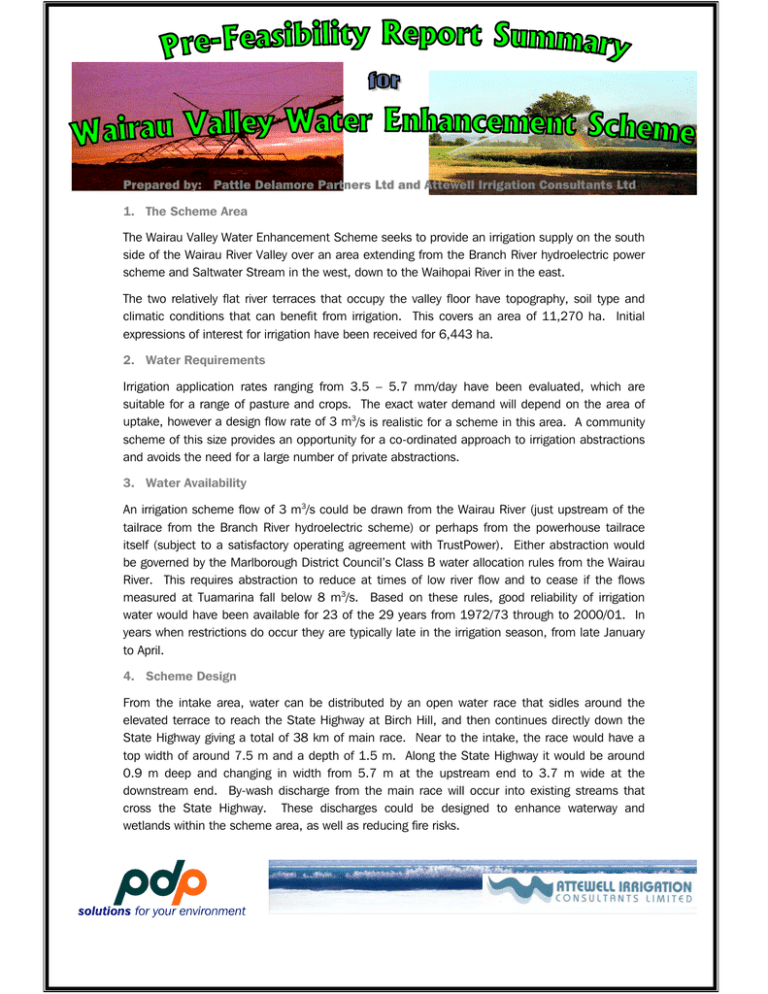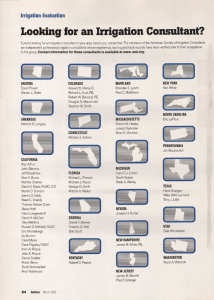Prepared by: Pattle Delamore Partners Ltd and Attewell Irrigation
advertisement

Prepared by: Pattle Delamore Partners Ltd and Attewell Irrigation Consultants Ltd 1. The Scheme Area The Wairau Valley Water Enhancement Scheme seeks to provide an irrigation supply on the south side of the Wairau River Valley over an area extending from the Branch River hydroelectric power scheme and Saltwater Stream in the west, down to the Waihopai River in the east. The two relatively flat river terraces that occupy the valley floor have topography, soil type and climatic conditions that can benefit from irrigation. This covers an area of 11,270 ha. Initial expressions of interest for irrigation have been received for 6,443 ha. 2. Water Requirements Irrigation application rates ranging from 3.5 – 5.7 mm/day have been evaluated, which are suitable for a range of pasture and crops. The exact water demand will depend on the area of uptake, however a design flow rate of 3 m3/s is realistic for a scheme in this area. A community scheme of this size provides an opportunity for a co-ordinated approach to irrigation abstractions and avoids the need for a large number of private abstractions. 3. Water Availability An irrigation scheme flow of 3 m3/s could be drawn from the Wairau River (just upstream of the tailrace from the Branch River hydroelectric scheme) or perhaps from the powerhouse tailrace itself (subject to a satisfactory operating agreement with TrustPower). Either abstraction would be governed by the Marlborough District Council’s Class B water allocation rules from the Wairau River. This requires abstraction to reduce at times of low river flow and to cease if the flows measured at Tuamarina fall below 8 m3/s. Based on these rules, good reliability of irrigation water would have been available for 23 of the 29 years from 1972/73 through to 2000/01. In years when restrictions do occur they are typically late in the irrigation season, from late January to April. 4. Scheme Design From the intake area, water can be distributed by an open water race that sidles around the elevated terrace to reach the State Highway at Birch Hill, and then continues directly down the State Highway giving a total of 38 km of main race. Near to the intake, the race would have a top width of around 7.5 m and a depth of 1.5 m. Along the State Highway it would be around 0.9 m deep and changing in width from 5.7 m at the upstream end to 3.7 m wide at the downstream end. By-wash discharge from the main race will occur into existing streams that cross the State Highway. These discharges could be designed to enhance waterway and wetlands within the scheme area, as well as reducing fire risks. solutions for your environment 5. Scheme Costs The estimated cost for the scheme is on the order of $4 million with per hectare costs of around $622/ha to $737/ha depending on the area to be supplied (i.e. around 4843 – 6443 ha). The annual operating cost is estimated to be around $25/ha. These costs are similar to the Waimakariri Irrigation Scheme, which operates successfully in Canterbury. Consideration should be given to an initial upsizing of the race capacity to allow for future development options. This could increase estimated costs by around 30% (i.e. up to $960/ha). 6. Storage Options Reliability of supply to the scheme can be improved by construction of large storage structures (3.5 – 6.7 million cubic metres). These have estimated costs of $3.2 - $6.3 million and therefore represent an increase in overall scheme costs of two to three times. This larger cost and the more significant environmental issues associated with large storage structures would significantly alter the scale of the irrigation scheme proposal. Smaller on-farm storage options in the size of 20,000 – 100,000 m3 can be pursued by individual landowners outside the scheme. This could be done to allow for short-term peak flow requirements, which could be needed, for example, for frost fighting. 7. Hydroelectric Power Options Hydroelectric power generation is most effective with larger race flows of 10 – 20 m3/s and/or large dam structures. This will result in larger capital costs and more significant environmental effects. As a result these components are not favoured as part of the initial scheme development. They can however be incorporated at a later date, once an irrigation scheme is up and running. TrustPower have expressed an interest in working with the Wairau Valley Water Enhancement Scheme with respect to hydroelectricity opportunities as well as the potential use of their Argyle storage pond and investment in the project as a whole. 8. Recommendation It is recommended that the option of a ‘run of the river’ gravity fed irrigation scheme sourced from Class B Wairau River water at or near the TrustPower tailrace be taken forward for a feasibility study. solutions for your environment




